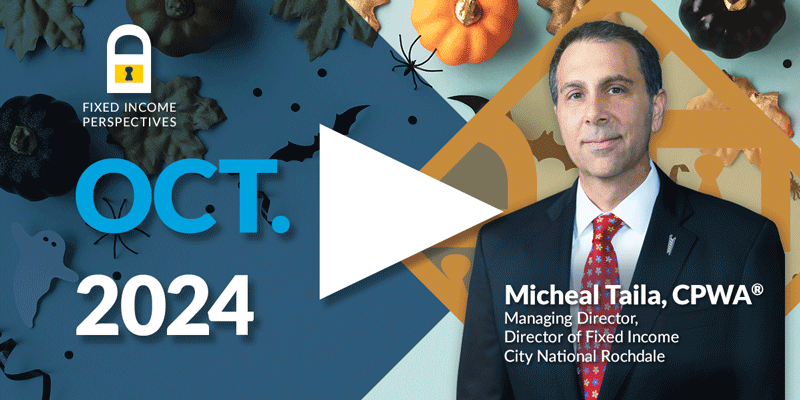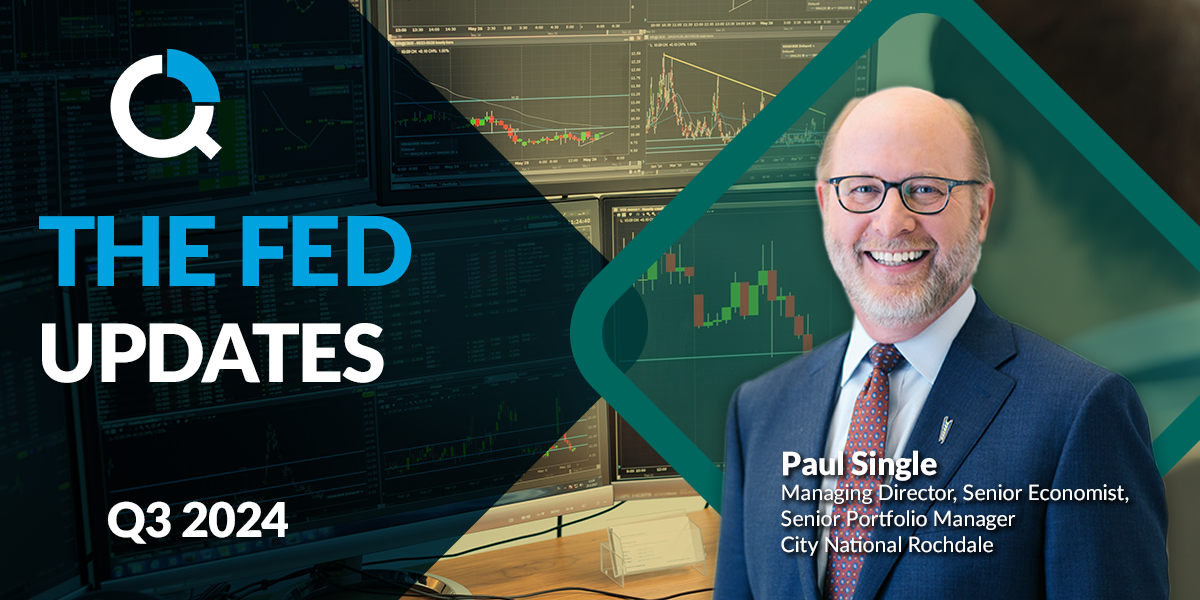

FAQs on the Markets and Economy
What should we expect next from the Fed?
The Federal Reserve meets eight times per year, typically scheduling six weeks between each meeting. The last meeting occurred on July 27 and the federal funds rate increased by 75 basis points (bps) as expected.
With Fed between 2.25% - 2.50%, managing monetary policy now becomes tricky as policy moves into more restrictive territory. According to Federal Reserve Chair, Jerome Powell, moving the target rate by 75 bps is unusually large and, to gauge the impact on the economy over a longer time frame, the Fed may shift to smaller interest rate adjustments at future meetings.
Since it takes time for monetary policy to impact the economy, a slower pace will mitigate the risk of overtightening and allow the Fed to rely more heavily on incoming data. Unfortunately, the gap between Fed meeting is longer than usual, and the next one won’t take place until Sept. 21, more than eight weeks after the previous meeting. Prior to this meeting, the market will receive data on real gross domestic product (GDP); two readings of consumer price index (CPI) and personal consumption expenditures (PCE) — once in July and once in August; eight weeks of jobs data, including two additional reports on the employment rate; and two months of consumer spending data. This has the potential to create volatility and could force the Fed to move more quickly instead of taking a measured approach. We believe that higher-for-longer inflation will force them to do just that.
Over the year 2022, the bond market has experienced the highest level of volatility in 50 years and our view is to expect more of the same. We recommend keeping portfolios aligned with long-term strategic objectives while staying nimble to capture mispriced assets in a sea of volatile data.

Is the economy in a recession with two consecutive negative quarters of GDP growth?
We do not think the economy is in a recession. Although some countries define a recession as two consecutive negative quarters of GDP growth, in the U.S., we do not.
For almost a century, the National Bureau of Economic Research (NBER) has been the self-appointed arbiter of the business cycle. They are precise about the dates but are not very timely with making an announcement. It can be up to a year before they make a statement. They wait until official data has been released and revised before they make a decision. That is why we do not officially know if the economy is in a recession.
The NBER defines a recession as a significant decline in economic activity spread across the economy, lasting more than a few months. It is normally visible in real GDP, real income, employment, industrial production, and wholesale-retail sales. The NBER uses six indicators to help define the economy; three are related to the labor market. Only two have moved into negative territory in the past three months (see chart). So although the overall pace of economic growth is slowing, it is not in a contraction mode.

What does the strong labor report mean for the Fed?
The Labor Department reported a booming increase in the July payrolls of 528,000 jobs, and the unemployment rate fell to 3.5% from 3.6%, matching a 50-year low.
The job gains were broad-based, and the total amount of workers has now surpassed the pre-recession peak and stands at a record 152.5 million. In short, the labor market is still hot.
This makes it very difficult for the Fed to battle inflation. Chair Powell and the company have been aggressively raising interest rates since March. Although some areas of the economy are slowing, like housing and household spending, with labor growing at a strong clip, it will keep wage growth strong. For almost a year now, the yearly change in average hourly earnings has averaged over 5%. To put that in perspective, it is more than 2x stronger than the average of the 10 years prior to the pandemic (see chart).
The Fed is concerned that higher wages could exacerbate the persistently high inflation. The report today will probably mean the Fed will remain steadfast in its rate increase for this year and next.

How will the midterm elections impact markets?
While markets continue to grapple with a long list of uncertainties, the just-around-the-corner midterm elections could be another source of potential volatility over the next two months.
Midterm election years have historically been the most volatile of the four-year presidential cycle, particularly the third quarter. The average intra-year decline for the S&P 500 intra-year decline in midterm election years is 19%, compared to just 13% in the other three years of the presidential cycle.
One factor explaining the volatility of midterm election years is elevated political uncertainty. Without knowing which political party will hold majorities in Congress, it’s unclear which economic policies will take priority. The good news is that election results provide the clarity that allows volatility to settle down. The years after midterm elections have historically been quite strong for stocks. Remarkably, the S&P 500 has been higher 12 months after every midterm election since 1950.
Elections matter; changes in which party holds the levers of power in government can have a significant impact on spending, taxes, regulation, and foreign policy. But it should also be noted that in the long run, equities have historically performed well under all combinations of political control. History shows trends in economic conditions, profit growth, valuations, and interest rates that ultimately matter.
Indeed, for all the focus in the media on potential changes in Washington, the direction of monetary policy has been the more powerful determinant of market performance over time. We suspect the same will be true this cycle, with future returns dependent on the Fed’s success in stemming the tide of higher inflation without pushing the economy into recession.

Important Disclosures
The information presented does not involve the rendering of personalized investment, financial, legal or tax advice. This presentation is not an offer to buy or sell, or a solicitation of any offer to buy or sell, any of the securities mentioned herein.
Certain statements contained herein may constitute projections, forecasts and other forward-looking statements, which do not reflect actual results and are based primarily upon a hypothetical set of assumptions applied to certain historical financial infor-mation. Certain information has been provided by third-party sources, and although believed to be reliable, it has not been inde-pendently verified, and its accuracy or completeness cannot be guaranteed.
Any opinions, projections, forecasts and forward-looking statements presented herein are valid as of the date of this document and are subject to change.
There are inherent risks with equity investing. These include, but are not limited to, stock market, manager or investment style risks. Stock markets tend to move in cycles, with periods of rising prices and periods of falling prices.
Investing in international markets carries risks such as currency fluctuation, regulatory risks and economic and political instability.
There are inherent risks with fixed income investing. These may include, but are not limited to, interest rate, call, credit, market, inflation, government policy, liquidity or junk bond risks. When interest rates rise, bond prices fall. This risk is heightened with in-vestments in longer-duration fixed income securities and during periods when prevailing interest rates are low or negative.
Investing involves risk, including the loss of principal.
As with any investment strategy, there is no guarantee that investment objectives will be met, and investors may lose money.
Past performance is no guarantee of future performance.
This material is available to advisory and sub-advised clients, as well as financial professionals working with City National Rochdale, a registered investment advisor and a wholly-owned subsidiary of City National Bank. City National Bank provides investment management services through its sub-advisory relationship with City National Rochdale.
Non Deposit Investment Products are: Not FDIC Insured, Not Bank Guaranteed, May Lose Value
The information presented does not involve the rendering of personalized investment, financial, legal, or tax advice. This presentation is not an offer to buy or sell, or a solicitation of any offer to buy or sell any of the securities mentioned herein.
Certain statements contained herein may constitute projections, forecasts and other forward-looking statements, which do not reflect actual results and are based primarily upon a hypothetical set of assumptions applied to certain historical financial information. Readers are cautioned that such forward-looking statements are not a guarantee of future results, involve risks and uncertainties, and actual results may differ materially from those statement. Certain information has been provided by third-party sources and, although believed to be reliable, it has not been independently verified and its accuracy or completeness cannot be guaranteed.
Past performance or performance based upon assumptions is no guarantee of future results.
Indices are unmanaged and one cannot invest directly in an index. Index returns do not reflect a deduction for fees or expenses.
Any opinions, projections, forecasts, and forward-looking statements presented herein are valid as on the date of this document and are subject to change.
All investing is subject to risk, including the possible loss of the money you invest. As with any investment strategy, there is no guarantee that investment objectives will be met and investors may lose money. Diversification does not ensure a profit or protect against a loss in a declining market. Past performance is no guarantee of future performance.
This material is available to advisory and sub-advised clients, as well as financial professionals working with City National Rochdale, a registered investment adviser and a wholly-owned subsidiary of City National Bank. City National Bank provides investment management services through its sub-advisory relationship with City National Rochdale.
INDEX DEFINITIONS
S&P 500 Index: The S&P 500 Index, or Standard & Poor’s 500 Index, is a market-capitalization-weighted index of 500 leading pub-licly traded companies in the U.S. It is not an exact list of the top 500 U.S. companies by market cap because there are other criteria that the index includes.
Muni Bond: A municipal bond is a debt security issued by a state, municipality or county to finance its capital expenditures, includ-ing the construction of highways, bridges or schools. These bonds can be thought of as loans that investors make to local govern-ments.
Bloomberg Barclays U.S. Corporate High Yield Bond Index: measures the USD denominated, high-yield, fixed-rate corporate bond market.
Dow Jones Select Dividend Index: The Dow Jones U.S. Select Dividend Index looks to target 100 dividend-paying stocks screened for factors that include the dividend growth rate, the dividend payout ratio and the trading volume. The components are then weighted by the dividend yield.
The SIFMA Municipal Swap Index: The Securities Industry and Financial Markets Association Municipal Swap Index is a 7-day high-grade market index comprised of tax-exempt Variable Rate Demand Obli-gations (VRDOs) with certain characteristics. The Index is calculated and published by Bloomberg. The Index is overseen by SIFMA’s Municipal Swap Index Committee.
CalPERS: The California Public Employees’ Retirement System, also known as CalPERS, is an organization that provides numerous benefits to its 2 million members, of which 38% are school members, 31% public agency members, and 31% state members.
4Ps: The 4P analysis is a proprietary framework for global equity allocation. Country rankings are derived from a subjective metrics system that combines the economic data for such countries with other factors including fiscal policies, demographics, innovative growth and corporate growth. These rankings are subjective and may be derived from data that contain inherent limitations.
Stay Informed.
Get our Insights delivered straight to your inbox.
Put our insights to work for you.
If you have a client with more than $1 million in investable assets and want to find out about the benefits of our intelligently personalized portfolio management, speak with an investment consultant near you today.
If you’re a high-net-worth client who's interested in adding an experienced investment manager to your financial team, learn more about working with us here


